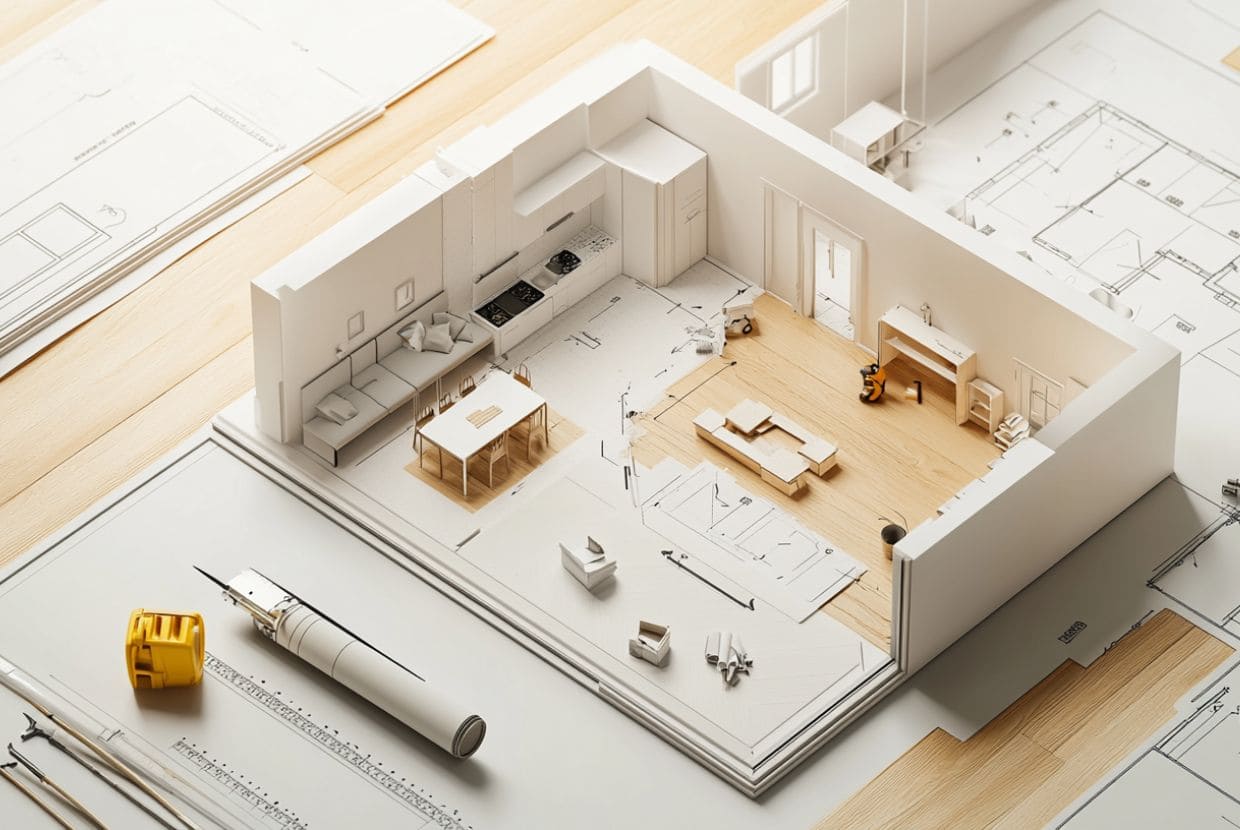There are many reasons why home improvements are advisable from time to time. They help improve the quality of life inside the home and increase the property's value in the event of a future sale. Today, we'll explain the best order for renovating a home and managing the work efficiently, making the most of your budget.
Step 1: Planning and diagnosis
The first step is to assess the condition of the property to identify areas that need improvement, replacement, or repair. This way, you can prioritize and plan the work appropriately.
During the planning phase, it's essential to have the assistance of professionals to help you with the diagnosis. If you're at this stage of the process, we recommend reading How to Choose the Best Renovation Company?
Step 2: Demolition and dismantling
Remove old coverings, floors and elements
The first step in the best order of home renovation is to strip the surfaces and other household structures. This is a job that requires care to avoid damaging the home. This way, you can begin cleaning and preparing the floors for the installation of new flooring.
Dismantle fixed furniture or structures to be replaced
It's necessary to identify furniture pieces that are already obsolete and need to be replaced. These must be carefully removed to free up space and facilitate the installation of new structures.
This phase will help you visualize the overall picture of the property and explore decorative and functional ideas.
Preparing the space for the new facilities
Floors, walls, ceilings, and all other structures on the property must be cleaned and leveled once the removals are complete. This step is necessary to prepare the property for the new installations you planned in the initial phase.
Step 3: Structural work and general repairs
Reinforcement of walls and structures (if necessary)
When determining the order of renovations to a house, the second priority is strengthening the walls and structures, always depending on their condition.
There are several structural reinforcement techniques that offer good results and save money in the long run. For example, concrete walls, steel mesh, and columns are recommended options with high performance. If you don't consider this step necessary, you can skip directly to the next one:
Repair of damage to walls and ceilings
Using filler, plaster, or fiberglass strips can correct imperfections in your home's walls. However, before using any of these materials, the damage must be assessed to determine which option will produce the best results.
Roof refurbishment should also be included in the list of home renovations, mainly because the materials mentioned above are also suitable for repairs.
Installation or modification of partitions to improve distribution
Using partition walls is recommended to optimally manage the space in your property. These allow for natural separations between different areas of the home, without reducing the space or affecting air circulation. If you're looking for new ideas for dividing spaces in your home, we invite you to check out our article: How to Separate a Room into Two Spaces?
The opposite may also apply, and you may want to knock down walls to create open spaces. In that case, we always recommend seeking professional advice.
Step 4: Installing and Updating Systems
Plumbing
Establishing a good piping system and plumbing solutions would be the fourth step in the order of home renovation, due to all the benefits it provides.
Electricity
Updating your home's electrical system is vital to prevent energy waste and reduce the risk of appliance accidents. Your electrical system must meet your basic needs efficiently, without the risk of overloads or short circuits. Ideally, it should also be as efficient as possible and help you save energy.
Other systems: Gas installation or air conditioning systems, if necessary
When planning your home renovation plan, don't forget about other essential systems, such as air conditioning, gas, security, lighting, and other elements you consider essential for your home.
Step 5: Cladding, insulation and enclosures
Installation of thermal and acoustic insulation on walls and ceilings
Limiting heat loss is essential to creating a comfortable atmosphere inside the home. Therefore, organic or inorganic thermal insulation is essential to enrich the domestic environment.
With soundproofing, you'll eliminate outside noise to avoid disturbances and maintain peace at home. Installing both types of insulation will help you live better while protecting your surroundings.
Installation of new walls, ceilings and, where appropriate, carpentry
Depending on the complexity of the project, the installation of these structures is necessary to change the appearance of the home or to make it more efficient. Installing doors and windows that help maintain the temperature inside the rooms is essential in any comprehensive renovation.
Surface preparation for final finishes
Old flooring must be removed to clean and level the floors in the house, allowing for the installation of new flooring. In addition to removing dirt, it's necessary to create a surface texture and repair visible defects to ensure a smooth installation.
Step 6: Finishes and final coatings
Laying new floors
Continuing with the order of renovations, the new floor should be installed once the preparation is complete. There is a wide selection of materials that can be used for flooring installation, including ceramic, wood, vinyl, and others.
Installation of tiles, wall coverings, or painting on walls and ceilings
Once the surface is finished, it's time to move on to the walls and ceilings to continue giving the home a more atmospheric look. At this stage, you can choose paint, tiles, or wall coverings, depending on your personal taste.
Paint is easier to apply and offers a wide range of pleasing shades, while tiles offer greater scope for customization. Cladding, on the other hand, provides more effective insulation protection.
Review of aesthetic and functional details
An appraisal is one of the final steps in a home renovation. It involves examining the changes made to ensure all improvements have been implemented correctly.
Step 7: Assembling furniture and decorative elements
Installation of built-in and fixed furniture
To begin adding functionality to your home, installing furniture is a crucial step. During this phase, built-in and fixed furniture will be your best allies due to the flexibility they offer.
Installation of decorative and lighting accessories
Decorative pieces add a unique essence to a home, as they help express your personal interests. Lighting systems are also essential to ensure visibility in all areas of the home.
Finishing touches to personalize the space
Finally, when renovating a home, you need to be both thorough and creative to put the finishing touches on your home. That is, you should review to make sure there are no mistakes and visualize spaces that can still be customized.
Tips for coordinating the renovation from start to finish in the best order for renovating a house
- Plan your design ahead of time, with the advice of qualified professionals.
- Coordinate with different suppliers to obtain the necessary materials.
- Compare quotes for different services to get the most value for your money.
- Set realistic goals for the changes you want to make to the property.
- Maintain constant communication with the work team, monitoring each stage of the project.
At Tecnic Project we are specialists in renovations in Mallorca.
Establishing the order for a home renovation is a necessary step for achieving an effective renovation of your property. Here at Tecnic Project, specialists in comprehensive renovations in Mallorca, we understand how complicated this process can be and want to help you.
Contact us so our team of specialists can advise and guide you through the complete renovation of your home in Mallorca, with clear goals and a personalized quote. If you prefer, you can schedule your appointment with us online .




